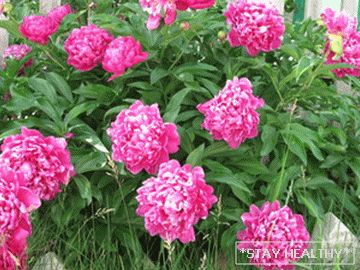 Thu, 10 Mar 2016
Thu, 10 Mar 2016
Род Пион (Paeonia) является единственным в
family peony (Paeoniaceae) and comes from the Southeast
Asia Peony flowers were cultivated many centuries before the new era in
China, Greece, Rome, where they were used as decorative and
medicinal plants.
The ancient Greek legend about the appearance of the peony is very beautiful. She is
talks about the fact that Peona, who once lived a young man, who was
the disciple of the god of healing Eskulap, the goddess of the darkness of the night Latona
bestowed a mysterious plant with amazing healing
properties. With the help of this plant he managed to heal the god of hell
Pluto from the wounds that were inflicted by Hercules. Because of this
The doctor lashed out his envy and decided to kill him. But Pluto,
grateful to Peon for the cure, did not let him die and turned him into
beautiful flower – peony.
In Russia, peonies appeared only in the time of Peter I, who
loved these flowers very much; in the first half of the XIX century, the Russian
the collection is replenished with luxurious varieties of French selection,
however, for a long time, peonies remained unexplored for
a wide range of color lovers. Only in the postwar years
domestic growers paid attention to him and started
selection, which resulted in many varieties of these
beautiful fragrant flowers.
The classification of garden peonies is based on differences in structure.
a flower that can be non-double-ended, Japanese, anemic,
semi-double, terry. In terms of flowering peonies are early
middle and late.
Contents
Peony – growing and care
For breeding pions it is best to choose open, sunny,
well warmed up places protected from winds. However without
air circulation increases the risk of developing diseases, therefore
the area where peonies grow should be somewhat removed from the buildings
and trees.
With strong shading in the afternoon, even for a few hours about the full
flowering plants can not even be speech. Best for pions
are loamy, well-dug up soils. In raw,
wetlands they do not take root, so if necessary
at a depth of 60-70 cm arrange drainage of rubble and gravel.
Peonies do not need to be watered often, however, with each watering should
spend 2-3 buckets on each adult bush so that water can
wet the soil to the depth of the roots. Especially important in
sufficiently moisten the soil in spring when the plant
buds are laid and flowering occurs, and at the end of summer, during
the time of planting flower buds. After watering the land is subject to
obligatory loosening, to preserve moisture in the soil, improve its
aerating and slowing the growth of weeds that take away flowers
nutrients and cause the spread and development
diseases.
In autumn, peon stalks must be cut at ground level and
burn, dusting their remains with ashes (for each bush up to 3
handfuls). Covering adult plants is not necessary.
Пион – пересадка и breeding
With appropriate preplant tillage and peony care
may be up to 20 years and even more in one place without
transplants. As a rule, the next year after planting development
the plants are slow, they start to bloom only the 2-3rd year,
every year more and more abundantly. Therefore, if you want to
Peonies always bloomed, do not need to replant them often.
If you still need to transplant flowers, then do it.
entirely, without division, does not follow, since such a plant will
grow poorly and bloom weakly because it will not develop
new root system.
The most common breeding method for pions is
division of rhizomes, which should be done in August or early
September With this method, the plant should be gently dig.
around and extract from the soil. Then, clearing it from the ground and removing
rotted roots, you need to cut them at an angle.
The best delenka is considered part of the bush, which has from 3 to 5 eyes
and the same number of roots. To divide bushes whose roots are lightly
they quit much easier. For planting peony bush need pit
from 50 to 60 cm deep and in diameter, its bottom follows
loosen to the depth of the shovel, and add there approximately half
volume mixture of topsoil and well decomposed
humus (10 kg) with mineral fertilizers (about 100 gr.). Plant
Delenki should be in such a way that the eyes are located on 5
cm below soil level. If they are higher, the plant can
freeze in winter; if below – then they will bloom badly. After
planting should be well compacted soil around the rhizome. Young
кусты способны цвести через два-три года после transplants.
Peony – diseases and pests
Peony is little affected by pests and various
diseases. Among them, the most common are gray
rot that affects buds, leaves, stalks, and ringed mosaic
leaves. To protect the peonies from disease, they are sprayed with 1%
Bordeaux liquid solution or other preparations containing
copper. Spraying is necessary before forming. buds and in
ideally – in the early spring for the first time, and after 10 days – the next.
Peonies can be exposed to various beetles and ants.
For example, before the beginning of flowering, their buds may devour bronze
beetles. They can be harvested by hand or sprayed.
plants with an appropriate fungicide.
And yet, to grow these flowers is quite simple, but for the beauty and
divine aroma is difficult for them to find equal among garden
cultures.





